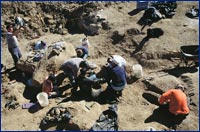|
By exploring
how the Earth works, environmental geoscientists at Notre Dame are finding
clues to pollution remediation that are earth-friendly.
Hollywood’s
Julia Roberts made a big splash as Erin Brockovich, the feisty young
mother
who fought and won a monumental law suit against the giant corporation
responsible for contaminating the water supply of a small town, causing
devastating illnesses and several deaths. The movie, perhaps more than
any single event in recent history, brought the issue of safe drinking
water to the surface.
From the time the Earth was formed, water has been continuously circulating;
it’s called the hydrologic cycle. As water evaporates, it forms
clouds, eventually returning to the earth as precipitation. It is the
precipitation that becomes part of the groundwater supply. Fifty percent
of the population of the United States depends solely on groundwater
generated from the cycle for its drinking water.
Groundwater is generally a safe source of drinking water. However, just
as they did in the movie Erin Brockovich, pollutants can contaminate
water supplies. Compounds from the Earth’s surface or man-made “products,” such
as storage tanks, hazardous waste sites, landfills, even catalytic converters,
can potentially move through the soil and leach into groundwater supplies
and the food chain in a variety of ways, affecting the circle of life.
The water cycle is just one example of the natural systems and processes
that environmental geoscientists study. Environmental geoscience is the
examination of Earth’s natural cycles that potentially impact or
are impacted by mankind. Thus, environmental geoscientists engage in
a wide variety of research from the atomic to the planetary scale to
provide a unique and quantitative perspective of Earth’s complex
systems, including an understanding of the role time plays in natural
processes.
Environmental geoscientists observe, measure, and analyze air, water,
soil, and rock formations to make recommendations on how best to preserve
the environment. They use their knowledge to design and monitor waste
disposal sites, safeguard water supplies, and reclaim contaminated soil.
They also study the composition and structure of the physical aspects
of the Earth -- past and present -- in order to make predictions about
its future.
“In many ways,” says James A.
Rigert, C.S.C., associate professor
of civil engineering and geological sciences, “environmental geoscientists
build on the role of the traditional geologist. The environmental thrust
provides an added enthusiasm to students, while faculty continue to emphasize
the fundamental knowledge of geology that
will help mankind understand the physical systems of the earth and remain
good stewards of its resources.”
 There are
many environmental study and geoscience programs at universities across
the country. What makes Notre Dame’s program unique is the
fact that it melds the two disciplines into a broad field which includes
aspects of geology, environmental engineering, chemistry, physics, biology,
and mathematics. Notre Dame’s program combines fundamental and
applied research to help students understand how the environment impacts
humanity, as well as how humanity impacts the environment. There are
many environmental study and geoscience programs at universities across
the country. What makes Notre Dame’s program unique is the
fact that it melds the two disciplines into a broad field which includes
aspects of geology, environmental engineering, chemistry, physics, biology,
and mathematics. Notre Dame’s program combines fundamental and
applied research to help students understand how the environment impacts
humanity, as well as how humanity impacts the environment.
“Environmental geoscience is very interdisciplinary,” says
Patricia A. Maurice, associate professor of civil engineering and geological
sciences. “Students
need to know geology, chemistry, physics, math, and biology, and they
have to be able to integrate them.” Why? Because environmental
geoscientists look at the big picture. For example, researchers have
to understand the mineral cycle, plate tectonics, and how continents
move. As the foundation of this knowledge, they must also be familiar
with the history of the earth and significant changes that have occurred
over time.
Consider volcanic activity, natural occurrences which strongly impact
human life and ecosystems. The Hawaiian Islands wouldn’t exist
if it weren’t for such activity. On the other hand, whole communities
have been badly damaged and some totally destroyed by volcanic eruptions.
Environmental geoscientists might study methods of diverting lava flows
or ways to predict eruptions. They might also study the earth’s
movement over time to predict where the next earthquake will hit or to
offer advice on construction and land use projects.
Environmental geoscientists spend a lot of time in the field, but they
also spend a great deal of time in their laboratories in pursuit of answers.
What follows is a sampling of the current research efforts of the faculty
in the environmental geosciences program at Notre Dame: |
 |
 |
 |
 |
 |
|
The Geologic Time Scale
 It looks very different from a Hallmark® calendar. Rocks, fossils,
and other artifacts mark its “pages.” The function of
the geologic time scale is to help researchers understand the world
in which we live. Since the Earth is constantly changing, knowledge
of its features and the natural processes relating to the Earth’s
past are just as vital to understanding the planet today as is mineralogy,
petrology, structural geology, oceanography, and environmental geology. It looks very different from a Hallmark® calendar. Rocks, fossils,
and other artifacts mark its “pages.” The function of
the geologic time scale is to help researchers understand the world
in which we live. Since the Earth is constantly changing, knowledge
of its features and the natural processes relating to the Earth’s
past are just as vital to understanding the planet today as is mineralogy,
petrology, structural geology, oceanography, and environmental geology.
Contrary to what the Jurassic Park movies would have people believe,
fossils encompass more than dinosaur bones. They are the remains
-- bones, shells, leaves, and other evidence such as tracks, burrows,
or impressions -- of life on earth millions of years ago. Researchers
who study fossils are called paleontologists. The purpose of their
work is to determine what happened in earth’s history and when
it happened. The three most important things to remember about fossils
are:
•
They represent the remains of once-living organisms.
•
Most of the fossils found belong to extinct species.
•
The fossils found in rocks of different ages are also different because
life on earth has throughout time.
Often the rocks in which fossils were formed provide as much useful
information about the environment or a historic natural event as
do the fossils themselves. For example, in 1999 a team led by J.
Keith Rigby, associate professor of civil engineering and geological
sciences, studied an area near the village of Chuanjie in the Yunnan
Province of China in order to determine the age of the materials
found there and develop an understanding of what happened to the
dinosaurs buried at the site. “What we discovered,” says
Rigby, “indicates three separate burial events, meaning the
site was visited continually or at least predictably for some time.”
Rigby believes there was some kind of mechanism to draw the animals
into the area, such as a playa lake, much like the temporary lakes
formed in the mountain basins of the western United States. It is
likely that the water grew so rich in mineral deposits that it became
toxic and killed the creatures that drank from the lake. Clues from
the soil and rock at the site support the theory that the site was
covered by three individual mud flows, probably during rainy seasons,
burying the carcasses and setting the stage for the next playa lake
and burial event.
 Rigby has also been very involved in several digs and a museum project
at Fort Peck, Mont. When completed, the Fort Peck Interpretative
Museum will feature a display of up to 60 dinosaurs with supporting
specimens from the environment of their day ... all based on the
information found in the fossils themselves and the rocks surrounding
them. Rigby has also been very involved in several digs and a museum project
at Fort Peck, Mont. When completed, the Fort Peck Interpretative
Museum will feature a display of up to 60 dinosaurs with supporting
specimens from the environment of their day ... all based on the
information found in the fossils themselves and the rocks surrounding
them.
The information gained from studying the past will hopefully help
in understanding the world of today, its natural chemical and physical
processes. Clues from the past can guide industry in the search for
new sources of water, oil, and coal. They may help researchers determine
where to expect earthquakes, floods, or landslides. They can also
assist mankind in becoming better stewards of the environment. By
knowing what happened on earth in the past and why, man can make
the future world a better one. |
|
|
|

